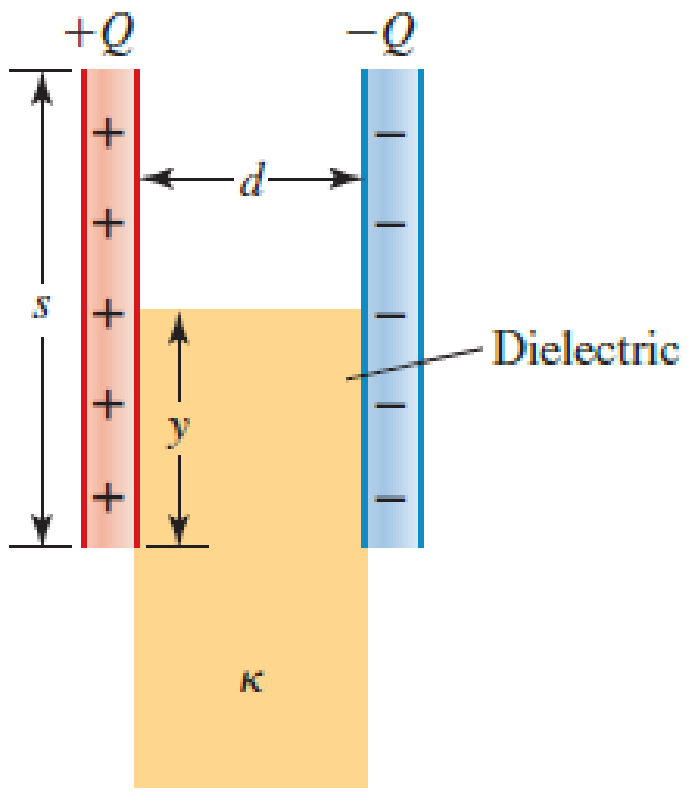
Concept explainers
A parallel-plate capacitor has square plates of side s = 2.50 cm and plate separation d = 2.50 mm. The capacitor is charged by a battery to a charge Q = 4.00 μC, after which the battery is disconnected. A porcelain dielectric (κ = 6.5) is then inserted a distance y = 1.00 cm into the capacitor (Fig. P27.88). Hint: Consider the system as two capacitors connected in parallel. a. What is the effective capacitance of this capacitor? b. How much energy is stored in the capacitor? c. What are the magnitude and direction of the force exerted on the dielectric by the plates of the capacitor?

Figure P27.88
(a)
Effective capacitance of the capacitor.
Answer to Problem 88PQ
Effective capacitance of the capacitor is
Explanation of Solution
Write the expression to find the capacitance of the parallel plate capacitor with dielectric.
Here,
Substitute
Write the expression to find the capacitance of the parallel plate which is unfilled.
Here,
Substitute
The system can be considered as two capacitors are connected in parallel.
Write the expression to find the equivalent capacitance of the two capacitors connected in parallel.
Here,
Conclusion:
Substitute
Therefore, effective capacitance of the capacitor is
(b)
The energy stored in the capacitor.
Answer to Problem 88PQ
The energy stored in the capacitor is
Explanation of Solution
Write the expression to find the equivalent capacitance of the two capacitors connected in parallel.
Here,
Substitute equations (I) and (II) in above expression to find the equivalent capacitance
Write the equation for energy stored in the capacitor.
Here,
Substitute equation (III) in above expression to find the energy stored in the capacitor.
Conclusion:
Substitute
Therefore, the energy stored in the capacitor is
(c)
The magnitude and direction of the force exerted on dielectric by the plates of capacitor.
Answer to Problem 88PQ
The magnitude and direction of the force exerted on dielectric by the plates of capacitor is
Explanation of Solution
Write the equation for energy stored in the capacitor.
Here,
Substitute equation (III) in above expression to find the energy stored in the capacitor.
Write the expression to find the force exerted on dielectric by the plates of capacitor.
Substitute equation (IV) in above expression to find the force exerted on dielectric by the plates of capacitor.
Conclusion:
Substitute
Therefore, the magnitude and direction of the force exerted on dielectric by the plates of capacitor is
Want to see more full solutions like this?
Chapter 27 Solutions
Physics for Scientists and Engineers: Foundations and Connections
- 3arrow_forward13. After a gust of wind, an orb weaver spider with a mass of 35 g, hanging on a strand of web of length L = .420 m, undergoes simple harmonic motion (SHO) with an amplitude A and period T. If the spider climbs 12.0 cm up the web without perturbing the oscillation otherwise, what is the period of oscillation, in Hz to three significant figures?arrow_forward15. An object of mass m = 8.10 kg is attached to an ideal spring and allowed to hang in the earth's gravitational field. The spring stretches 23.10 cm before it reaches its equilibrium position. The mass then undergoes simple harmonic motion with an amplitude of 10.5 cm. Calculate the velocity of the mass in m/s at a time t= 1.00s to three significant figures.arrow_forward
- please solve and answer the question correctly. Thank you!!arrow_forward18arrow_forward1. Some 1800 years ago Roman soldiers effectively used slings as deadly weapons. The length of these slings averaged about 81 cm and the lead shot that they used weighed about 30 grams. If in the wind up to a release, the shot rotated around the Roman slinger with a period of .14 seconds. Find the maximum acceleration of the shot before being released in m/s^2 and report it to two significant figures.arrow_forward
- 16arrow_forward11. A small charged plastic ball is vertically above another charged small ball in a frictionless test tube as shown in the figure. The balls are in equilibrium at a distance d= 2.0 cm apart. If the charge on one ball is tripled, find the new equilibrium distance between the balls in cm and report it to the proper number of significant figures.arrow_forward12. The electric field at a point 1.3 cm from a small object points toward the object with a strength of 180,000 N/C. Find the object's charge q, in nC to the proper number of significant figures. k = 1/4πε0 = 8.99 × 10^9 N ∙ m^2/C^2arrow_forward
- 14. When the potential difference between the plates of an ideal air-filled parallel plate capacitor is 35 V, the electric field between the plates has a strength of 670 V/m. If the plate area is 4.0 × 10^-2 m^2, what is the capacitance of this capacitor in pF? (ε0 = 8.85 × 10^-12 C^2/N ∙ m^2)arrow_forward10. A small styrofoam ball of mass 0.500 g is placed in an electric field of 1140 N/C pointing downward. What excess charge must be placed on the ball for it to remain suspended in the field? Report your answer in micro-Coulombs to three significant figures.arrow_forward2arrow_forward
 Physics for Scientists and Engineers: Foundations...PhysicsISBN:9781133939146Author:Katz, Debora M.Publisher:Cengage Learning
Physics for Scientists and Engineers: Foundations...PhysicsISBN:9781133939146Author:Katz, Debora M.Publisher:Cengage Learning College PhysicsPhysicsISBN:9781285737027Author:Raymond A. Serway, Chris VuillePublisher:Cengage Learning
College PhysicsPhysicsISBN:9781285737027Author:Raymond A. Serway, Chris VuillePublisher:Cengage Learning College PhysicsPhysicsISBN:9781305952300Author:Raymond A. Serway, Chris VuillePublisher:Cengage Learning
College PhysicsPhysicsISBN:9781305952300Author:Raymond A. Serway, Chris VuillePublisher:Cengage Learning Physics for Scientists and Engineers with Modern ...PhysicsISBN:9781337553292Author:Raymond A. Serway, John W. JewettPublisher:Cengage Learning
Physics for Scientists and Engineers with Modern ...PhysicsISBN:9781337553292Author:Raymond A. Serway, John W. JewettPublisher:Cengage Learning Principles of Physics: A Calculus-Based TextPhysicsISBN:9781133104261Author:Raymond A. Serway, John W. JewettPublisher:Cengage Learning
Principles of Physics: A Calculus-Based TextPhysicsISBN:9781133104261Author:Raymond A. Serway, John W. JewettPublisher:Cengage Learning Physics for Scientists and Engineers, Technology ...PhysicsISBN:9781305116399Author:Raymond A. Serway, John W. JewettPublisher:Cengage Learning
Physics for Scientists and Engineers, Technology ...PhysicsISBN:9781305116399Author:Raymond A. Serway, John W. JewettPublisher:Cengage Learning





